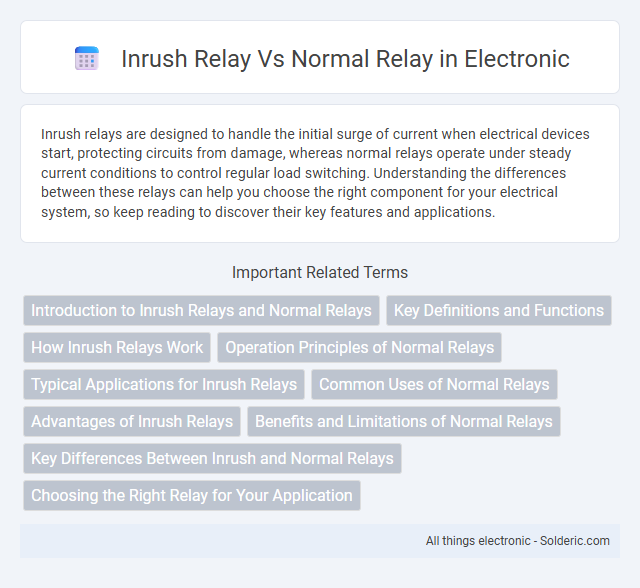Inrush relays are designed to handle the initial surge of current when electrical devices start, protecting circuits from damage, whereas normal relays operate under steady current conditions to control regular load switching. Understanding the differences between these relays can help you choose the right component for your electrical system, so keep reading to discover their key features and applications.
Comparison Table
| Feature | Inrush Relay | Normal Relay |
|---|---|---|
| Primary Function | Limits or delays response to high inrush current | Switches electrical circuits on/off immediately |
| Application | Protects devices with high startup current (motors, transformers) | General-purpose circuit control |
| Response Time | Delayed activation to ignore transient inrush | Immediate switching |
| Current Handling | Handles surge or inrush currents safely | Handles steady-state load current |
| Protection | Prevents nuisance tripping from inrush current | No special protection against inrush current |
| Cost | Generally higher due to complex design | Lower cost, simpler design |
Introduction to Inrush Relays and Normal Relays
Inrush relays are specialized devices designed to handle the initial surge of current that occurs when electrical equipment, such as motors or transformers, is first energized. Normal relays, on the other hand, function primarily to open or close circuits under normal operating conditions without specific consideration for inrush current management. Understanding the distinct roles and operational characteristics of inrush relays versus normal relays is critical for ensuring proper protection and longevity of electrical systems.
Key Definitions and Functions
An inrush relay protects electrical circuits by sensing and limiting the initial surge of high current when equipment like transformers or motors start up, preventing potential damage. A normal relay operates by switching electrical circuits on or off based on control signals without specific sensitivity to current surges. Understanding the distinction between inrush relays and normal relays ensures your system's reliability and safety during startup conditions.
How Inrush Relays Work
Inrush relays protect electrical equipment by limiting the initial surge current when devices like transformers or motors start, preventing damage and extending lifespan. Unlike normal relays, inrush relays detect the high inrush current and delay the connection of the load to avoid tripping or overheating. Your system benefits from minimized electrical stress and improved operational stability by using inrush relays in high surge current applications.
Operation Principles of Normal Relays
Normal relays operate by using an electromagnetic coil to generate a magnetic field when current flows through it, which then moves a mechanical armature to open or close contacts. The operation is straightforward, designed to switch electrical circuits on or off based on control signals without handling large transient currents. Understanding this principle helps you select the appropriate relay type for your specific application, especially when distinguishing from inrush relays that manage high initial surge currents.
Typical Applications for Inrush Relays
Inrush relays are designed primarily for motor protection and transformer energizing applications where they prevent nuisance tripping due to high initial current surges. These relays are commonly used in industrial motor starters, HVAC systems, and large transformers to handle the inrush current safely without damaging the equipment. Your electrical systems benefit from inrush relays by improving reliability and minimizing downtime compared to normal relays that may trip prematurely under transient currents.
Common Uses of Normal Relays
Normal relays are widely used in automotive circuits, home automation systems, and industrial equipment for switching electrical loads safely and efficiently. These electromechanical devices control high-power circuits with low-voltage signals, making them essential in motor control, lighting systems, and HVAC applications. Unlike inrush relays, normal relays do not have special mechanisms to handle high initial current surges but provide reliable switching for standard electrical loads.
Advantages of Inrush Relays
Inrush relays offer significant advantages by effectively managing high inrush currents during the startup of electrical devices, protecting your equipment from potential damage and extending its lifespan. Unlike normal relays, inrush relays prevent nuisance tripping and reduce mechanical wear by delaying contact engagement until the initial surge subsides. This precise control enhances system reliability and ensures smoother operation in applications involving transformers, motors, and lighting systems.
Benefits and Limitations of Normal Relays
Normal relays offer straightforward switching capabilities, enabling efficient control of electrical circuits with low cost and simple design. Their benefits include ease of use and compatibility with a wide range of applications, but they lack the ability to limit inrush current, which can cause contact welding or premature wear. You should consider their limitations in high inrush scenarios where specialized devices like inrush relays provide enhanced protection and longevity.
Key Differences Between Inrush and Normal Relays
Inrush relays are specifically designed to handle high initial surge currents, protecting circuits during startup by delaying the relay operation or limiting the inrush current, whereas normal relays switch electrical loads without any specific surge current management. Inrush relays often feature time-delay mechanisms and higher current tolerance to prevent contact welding and damage, while normal relays operate immediately with standard current ratings suitable for steady-state conditions. The key difference lies in the inrush relay's ability to manage transient currents effectively, enhancing reliability in applications like motor starting and transformer energizing compared to conventional relays.
Choosing the Right Relay for Your Application
Choosing the right relay for your application is crucial, especially when managing high inrush currents where an inrush relay provides superior protection by delaying the connection to prevent damage. Normal relays operate with immediate switching, suitable for standard current loads but may fail to handle sudden surges effectively. Assessing your system's current profile and load requirements ensures your equipment operates safely and reliably with the appropriate relay type.
Inrush relay vs normal relay Infographic

 solderic.com
solderic.com